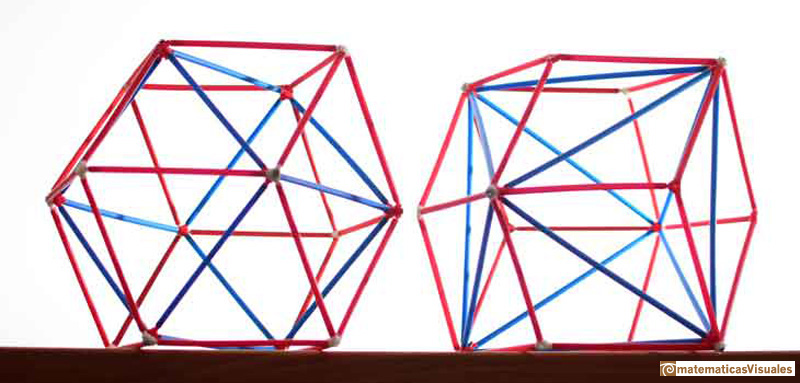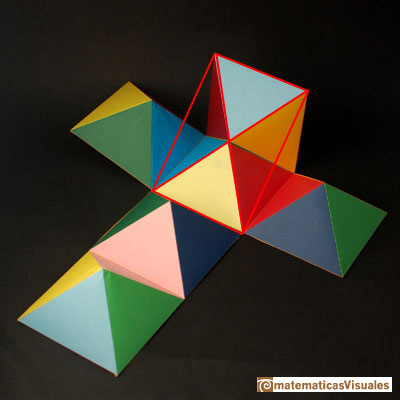- About MAA
- Membership
- MAA Publications
- Periodicals
- Blogs
- MAA Book Series
- MAA Press (an imprint of the AMS)
- MAA Notes
- MAA Reviews
- Mathematical Communication
- Information for Libraries
- Author Resources
- Advertise with MAA
- Meetings
- Competitions
- Programs
- Communities
- MAA Sections
- SIGMAA
- MAA Connect
- Students
- MAA Awards
- Awards Booklets
- Writing Awards
- Teaching Awards
- Service Awards
- Research Awards
- Lecture Awards
- Putnam Competition Individual and Team Winners
- D. E. Shaw Group AMC 8 Awards & Certificates
- Maryam Mirzakhani AMC 10 A Awards & Certificates
- Two Sigma AMC 10 B Awards & Certificates
- Jane Street AMC 12 A Awards & Certificates
- Akamai AMC 12 B Awards & Certificates
- High School Teachers
- News
You are here
Kepler and the Rhombic Dodecahedron: The Rhombic Dodecahedron as a Cube with Pyramids
We have now seen two of the different approaches that Kepler used to study the rhombic dodecahedron.
First, he identified this polyhedron by looking at how bees build their cells. He was inspired by nature.
Second, he found the rhombic dodecahedron as a result of squeezing cannonballs. This study was related to a technical problem.
Both these points of view are wonderful examples of what Kepler's creative mind was able to accomplish. But if we want to gain a deeper mathematical understanding of the rhombic dodecahedron—for example, by finding the length of the two diagonals of its rhombi, its volume, or the measure of its angles—another approach would be helpful. And it was Kepler, once again, who gave us a way to see the rhombic dodecahedron that not only makes it simpler to do these basic calculations, but also gives yet another beautiful explanation of why this polyhedron tessellate space.
The key to this third point of view was that Kepler understood that the rhombic dodecahedron can be seen as an 'elevatus' cube: a cube with six special pyramids attached.
In his book Epitome Astronomiae Copernicanae [Kepler 1618–1621], Kepler wrote about the rhombic dodecahedron once more and drew the following clarifying picture:
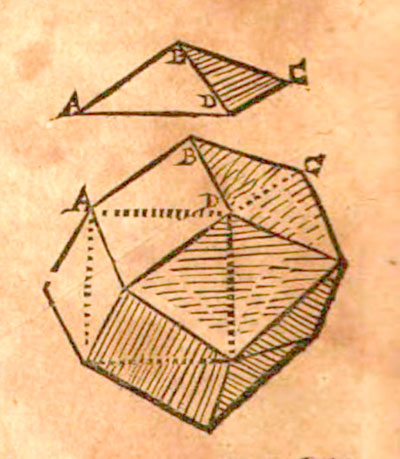
Figure 25. Kepler, Epitome Astronomiae Copernicanae [1618–1621, 460]. A cube with augmented pyramids.
In the following video, we can see how changing the height of the pyramids attached to a cube results in different polyhedra with 24 triangular faces. But, when those pyramids reach a certain precise height, pairs of neighboring triangular faces lie in the same plane and become rhombi.
Animation of cube augmented with pyramids of different heights.
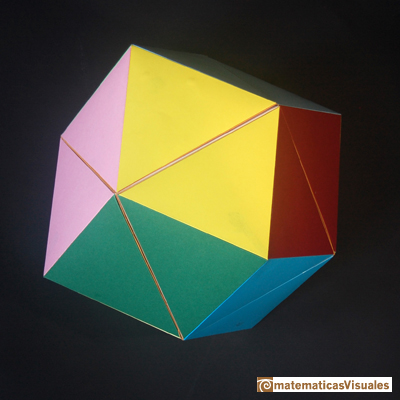
Figure 26. A cube with augmented pyramids. Cardboard and magnets.
What consequences can we derive from this approach to viewing the rhombic dodecahedron? Here, we outline the ideas behind four basic properties of this polyhedron and provide links to investigations that explore two others.
1) First, we can inscribe a cube inside a rhombic dodecahedron.
Figure 27. A rhombic dodecahedra with an inscribed cube (at left) and an inscribed octahedron (at right); the rhombic dodecahedra are shown in red and the inscribed polyhedra in blue.
Notice that the cube is produced by linking the eight vertices of the rhombic dodecahedron. Can you see which polyhedron we get when we link the six vertices where four edges of the rhombic dodecahedron meet? (The answer to this question is revealed in Figure 27 and discussed further below.)
2) Second, we can calculate some basic measurements; namely, the lengths of the diagonals of each face and the length of the polyhedron’s edges.
To do this, we need the precise height h of the raised pyramid that gives us the rhombic dodecahedron; this is not very difficult to calculate. To see the details of the computations and learn the values of these lengths, click here.
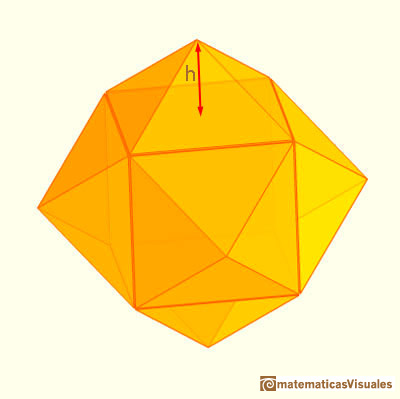
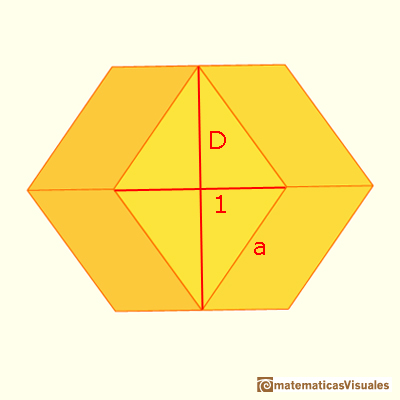
3) There is a basic relation between the volume of the rhombic dodecahedron and the volume of the inscribed cube. Namely, the volume of the rhombic dodecahedron is double the volume of the inscribed cube.
To see this, notice that the six pyramids that we attach to the cube in order to create the rhombic dodecahedron can instead be put inside that cube with their vertices joined at the center of the cube. The following video illustrates one approach to visualizing this relationship:
Turning a rhombic dodecahedron inside-out..
It is not difficult to build a model of the construction in this last video by using cardboard (with magnets inside), as shown in Figure 28.
Figure 28. A cube with pyramids attached, with a section of the cube outlined in red. Note that the pyramids can be turned either to the outside of the cube (to give a rhombic dodecahedron) or placed on the cube’s inside. Cardboard and magnets.
We can use this “double” relationship between the volume of the rhombic dodecahedron and the volume of the inscribed cube to write the volume of a rhombic dodecahedron as a function of its edge length. To see the details of this computation, click here.
4) We can tessellate space with rhombic dodecahedra.
Hugo Steinhaus described this property in a simple and precise way:
We have already mentioned filling the whole of space with cubes. We can get another filling of this sort by the following procedure: we make the cubes alternately black and white to get a kind of chessboard and then we remove the black ones. We decompose each void space into 6 pyramids on square bases with a common vertex in the center of the void space. If we consider a single white cube with 6 pyramids based on it, we see a rhombi dodecahedron with a cube inscribed in it; it is obvious that by our procedure we have filled the whole of space with congruent rhombic dodecahedra. . . . The vertices are of two kinds: (1) where 4 solids meet; (2) where 6 solids meet [Steinhaus 1983, 185–186].
Tessellating space with the rhombic dodecahedron.
Kepler was well aware of this property. For example, he wrote in his book De Nive Sexangula:
[The rhombic dodecahedron] shares this property with the cube: that just as eight corners of eight cubes brought together at a single point will fill the space entirely and leave no gap, so will the corners of the first kind of rhombic figure, when four of the obtuse (trilateral) angles or six of the quadrilateral angles come together. Thus, a space can be completely filled just with rhombic figures of this kind, as long as four three-sided angles or six four-sided angles always come together at a single point, so that a solid whole is made. . . .
This, then, is the geometric figure closest to a regular solid that fills a space entirely, just as the hexagon, the square, and the triangle fill a plane. It is the very shape that bees produce in their honeycombs, except for the fact that their cells lack a roof to match the bottom [Kepler 1611, 45].
|
|
TO INVESTIGATE Density of the optimal sphere packing. Using what we now know about the volume of the rhombic dodecahedron and its space-tessellation property, we can also calculate the density of the optimal sphere packing, using the rhombic dodecahedron as a unit cell. |
Roberto Cardil (matematicasVisuales), "Kepler and the Rhombic Dodecahedron: The Rhombic Dodecahedron as a Cube with Pyramids ," Convergence (March 2022)

